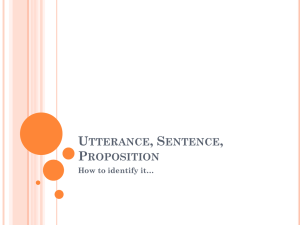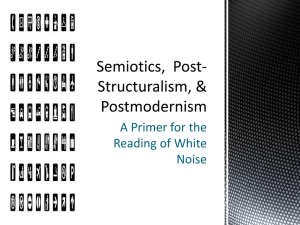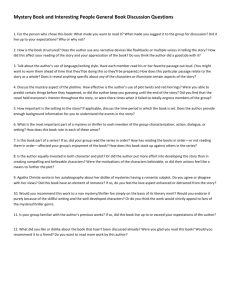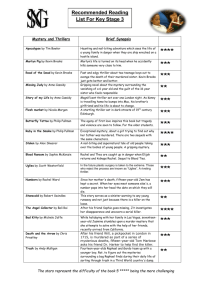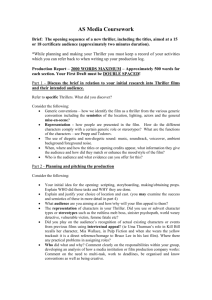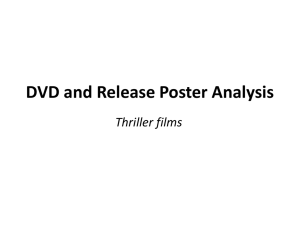representation theory
advertisement
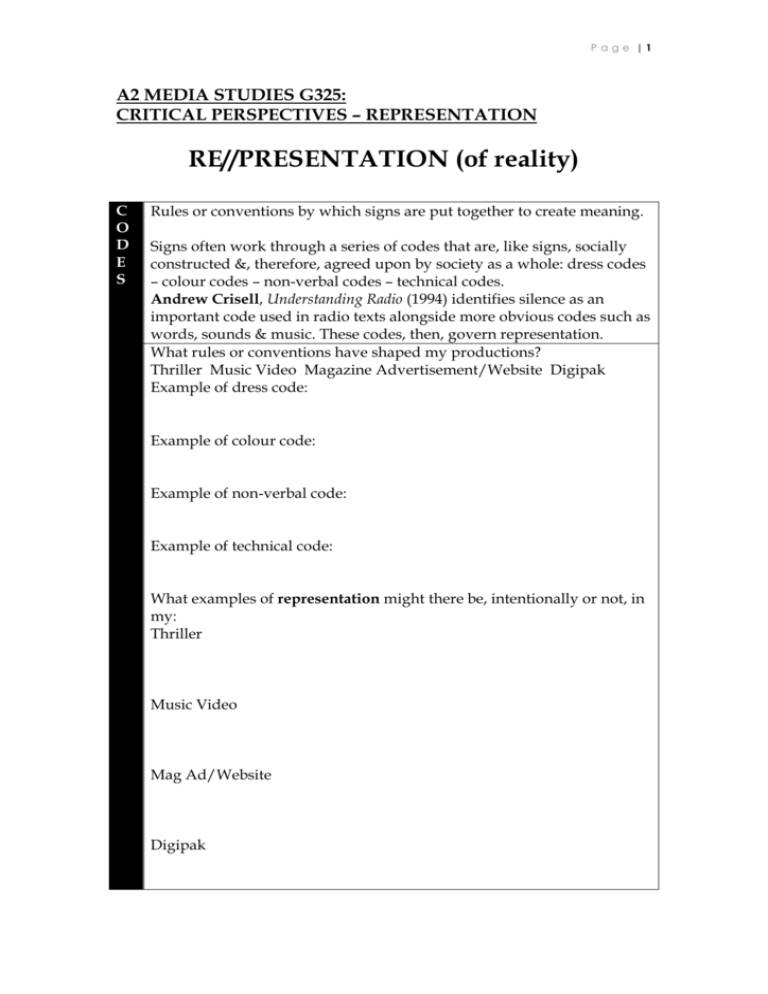
P a g e |1 A2 MEDIA STUDIES G325: CRITICAL PERSPECTIVES – REPRESENTATION RE//PRESENTATION (of reality) C O D E S Rules or conventions by which signs are put together to create meaning. Signs often work through a series of codes that are, like signs, socially constructed &, therefore, agreed upon by society as a whole: dress codes – colour codes – non-verbal codes – technical codes. Andrew Crisell, Understanding Radio (1994) identifies silence as an important code used in radio texts alongside more obvious codes such as words, sounds & music. These codes, then, govern representation. What rules or conventions have shaped my productions? Thriller Music Video Magazine Advertisement/Website Digipak Example of dress code: Example of colour code: Example of non-verbal code: Example of technical code: What examples of representation might there be, intentionally or not, in my: Thriller Music Video Mag Ad/Website Digipak P a g e |2 S E M I O T I C S S T R U C T U R A L I S M Semiology (Greek word semeion) = SIGN An attempt to create a science of the study of sign systems & their role in the construction & reconstruction of meaning in media texts. Concentrates primarily on the text itself & the signs and codes that are contained within. Barthes (see below) applied these ideas of semiotics to everyday life & popular culture. Therefore, if you look at how meanings are constructed in your product, you can suggest how they represent the reconstruction of meaning to an audience. INFORMATION Ferdinand de Saussure (1857-1913) Produced structuralist (see below) work that first promoted the idea of semiology, seeing language as a cultural creation & a social system that was governed by a set of rules. Charles Peirce (1839-1914) Took Saussure’s ideas & applied to other social constructs in society (itself governed by sets of rules). Roland Barthes (1913-1980) Barthes was influenced by Saussure & became one of the most influential theorists applying semiotic analysis to daily life, popular culture & contemporary issues. This approach argues that identifying underlying structures is allimportant in undertaking analysis: linguistics = grammatical structures; social structures = family units etc. Semiotic analysis is a useful tool in the deconstruction of texts > reveals the underlying meanings that are ‘suspended’ within a text > further analysis allows consideration of the ideologies that underpin texts & their construction. Q: If I look at the representations I have created of, say, males & female in my product, what are the basic meanings that I have created? Q: If I apply semiotic analysis to these representations can I discover any further underlying meanings &, if I probe deeper, can I find any evidence of ideologies present? P a g e |3 Q: What other areas (codes) do I need to analyse the representation of (race, class, colours...)? Please list: R E A D E R We, the audience, are called ‘readers’ – this helps to suggest a greater degree of creativity & involvement in the construction of the text’s meaning. “Reading’ is something we learn to do & is shaped by our social & cultural background: we are likely to bring something of our own ‘cultural baggage’ to the text. Barthes: “The birth of the reader is the death of the author.” Mythologies 1972. Q: What do you think that Barthes meant by this? Q: Apply Barthes’ quote to your 4 products; what different readings might audiences have of the representations contained within your products? Thriller Music Video Mag Ad/Website Digipak P a g e |4 S I G N S Fiske & Hartley in Reading Television (1978) describe the sign: Signifier + signified = sign; a physical object + a mental concept or meaning conveyed by the signifier. This, then, becomes the representation that the reader has decoded. A music video is a sign. It consists of a signifier - the music video itself - and something that is signified - the ‘ideas’ or ‘meaning’ behind the set of images and sounds used in the video. Q: Apply this simple procedure to your 4 products, suggesting at least one representation that is signified by your signifier? Signifier = Signified (represents) = Signifier = Signified (represents) = Signifier = Signified (represents) = Signifier = Signified (represents) = S P a g e |5 I G N S Peirce > 3 types of signs: symbolic (or arbitrary); iconic; indexical. Symbolic – no obvious connection between sign & object > the word CAT has no obvious link with small furry animal > only works because we know the rules that say C-A-T, when put in a certain order, mean or ‘signify’ that small furry animal (if ‘we’ was French then it would be CH-A-T). They are arbitrary because they can have several meanings depending upon who is reading the sign. The Union Jack. Q: List the as many groups as you can that have different meanings of the representation of this flag (some prompts at bottom of page)? Indexical – a direct connection with what is being ‘signified’. Smoke is often used as an indexical sign for _ _ _ _ A tear running down a face is an indexical sign for ______ (British monarchy, Unionists in Ulster, mods in Quadrophenia (1979) or BNP) P a g e |6 S I G N S Iconic – like religious paintings, or photographs, these signs have a physical similarity to the objects they that they ‘signify’. Q: What does this iconic sign represent? Q: What does this iconic sign represent? It is iconic signs which are especially significant in the study of the visual image; because iconic signs so closely resemble the item that they represent, that they seem natural = easy to confuse the sign with reality itself = important implications for the way in which we read the representation of reality in the media. Q: Looking at the visual images in your 4 products, what iconic signs can you see and how might an audience confuse these representations with reality? Thriller Music Video Mag Ad/Website Digipak P a g e |7 P O L Y S E M I C Media texts can have several meanings depending on the way in which the signs are read & the background of the individual ‘reader’ = open to many interpretations, ambiguous or polysemic. Sometimes, however, there is a preferred meaning that is indicated by the way the text has been produced & presented to the reader. Q: Try to look at your 4 products with ‘fresh’ eyes: is there a preferred meaning for the representations that you have created & presented; are any of your representations polysemic? Thriller Preferred: Polysemic: Music Video Preferred: Polysemic: Mag Ad/Website Preferred: Polysemic: Digipak Preferred: Polysemic: P a g e |8 A N C H O R A G E The fixing or limiting of a particular set of meanings to an image. Common forms include captions underneath photographs & brand names across perfume advertisements. Q: Find several good examples of images that have been ‘anchored’ from the internet, then try to think of how you might have anchored meaning in any of the representations that you have created in your 4 products? Thriller Music Video Mag Ad/Website Digipak DENOTATION CONNOTATION Barthes: what an image actually shows & is immediately apparent, rather than the assumptions an individual reader may make about it. The meaning of a sign which is arrived at through the cultural experiences a reader brings to it. Q: How does this apply to my products? The photograph of _________________________________ on my digipak denotes _____________________________ __________________________________________________ (describe the image using technical codes), this representation connotes __________________________________________ __________________________________________________ (suggest the meaning, or meanings, that the image should/could represent) P a g e |9 PROCESS MODEL An earlier model which considers the audience’s OF interaction with the media as part of a linear process: COMMUNICATION SENDER>CHANNEL>MESSAGE>RECEIVER where the meaning of the text is thought to be ‘fixed’ by the producer. Semiotic analysis has replaced this model, can you suggest why (what is wrong with this model) & give an example? PROBLEMS WITH SEMIOTICS 1. Not really a ‘science’ in the way that Barthes claimed, & because of polysemic readings there is some difficulty in judging which interpretations are most valid. 2. Difficult to measure the effect of the audience or reader in creating signs: e.g. flowers left after death of Diana, Princess of Wales, could ‘signify’ national mourning but could not say whether people were expressing their sorrow or media manipulation of that sorrow. 3. Critics suggest that denotation stage is not very useful because it is so artificial & all readers automatically ‘add’ connotations. Q: What do you think of these 3 problems and can you apply any of them to any area of your 4 products? 1. 2. 3. P a g e | 10 REPRESENTATION Your reflective writing will be a fluid interplay between the personal (as a wo/man) & the academic (as a student analysing your own creative outcomes in theoretical contexts). B A R T H E S “Striptease is based on a contradiction. Woman is desexualised at the very moment when she is stripped naked. We may therefore say that we are dealing here with a spectacle based on fear.” Mythologies (1972). He is suggesting that clothes sexualise women more than the naked body itself, which is why the female stripper leaves the stage at the point of removing the last garment. We can see evidence of this in all media & especially in… the appearance of female pop artists. (paraphrasing J McDougall, in OCR Media Studies for A2 (2009)). Q: Can you apply this approach to the representation of a female (or male, to take it one step further) artist in your music video / mag ad/website / digipak or actor in your thriller? L A U R A “In a world ordered by sexual imbalance, pleasure in looking has been split between active/male & passive/female. The determining male gaze projects its phantasy on to the female figure which is styled accordingly.” (Mulvey in Humm 1992). Mulvey’s hugely influential theory (The male Gaze) is actually quite simple: men look at women & the media reinforce this by filming or photographing women from a male point of view – so the norm for media representation is that the camera is male. Q: Looking at your 4 products, is there any evidence to suggest that the representations in your products are from a male perspective & are therefore applicable to the male gaze theory? Thriller M U L V E Y Music Video Mag Ad/Website Digipak P a g e | 11 REPRESENTATION Your reflective writing will be a fluid interplay between the personal (as a wo/man) & the academic (as a student analysing your own creative outcomes in theoretical contexts). S C O P O P H I L I A Literally, the love of looking. A term derived from the predominantly male gaze of Hollywood cinema, which enjoys objectifying women into mere objects to be looked at (rather than subjects with their own voice & subjectivity). The term, as used in feminist film criticism, is heavily influenced by Freudian & Lacanian psychoanalysis. Q: Can you identify any representations in your 4 products that have objectified women & are scopophilic OR have you consciously avoided scopophilia in creating your representations? Thriller Music Video Mag Ad/Website Digipak P a g e | 12 REPRESENTATION Your reflective writing will be a fluid interplay between the personal (as a wo/man) & the academic (as a student analysing your own creative outcomes in theoretical contexts). F E M I N I S M + O P P R E S S I O N “Historically people & movements have been called feminist when they recognised the connections between social inequalities, deprivations & gender differences. Currently feminists are pursuing questions about the consequences for women & men when gender oppressions intersect with other forms of oppression, with homophobia, classism, ageism, disability & racism.” Humm (1992). 17 years on is there more symbolic oppression in the media than at the time of Humm’s description? > the xenophobic reaction to Islam in the post 9/11 context, & the gradual erosion of civil liberties which is partly facilitated by media representations of ‘the threat’. Sometimes media studies has to be political; selling music as a commodity through media art whilst remaining embedded in political cultural practices that make a difference to how we treat each other in daily social life. (paraphrasing J McDougall, in OCR Media Studies for A2 (2009)). Q: Have you sold music as a commodity in your media art & have you used representations that might make a difference to the daily interaction of people? Music Video Mag Ad/Website Digipak P a g e | 13 REPRESENTATION Your reflective writing will be a fluid interplay between the personal (as a wo/man) & the academic (as a student analysing your own creative outcomes in theoretical contexts). R I C H A R D D Y E R S t e r e o t y p e s You have already applied Dyer’s theory about the construction of a star image to your music video; this can also be applied to the website & digipak. In The Matter of Images (1993) Dyer points out the dangers of thinking rigidly in terms of stereotypes when dealing with representation. “A stereotype can be complex, varied, intense & contradictory, an image of otherness in which it is still possible to find oneself.” Stereotypes, he points out, are not always or necessarily negative, although some, such as the black mammy of Hollywood, are very limiting. The process of stereotyping involves power; the power of the dominant groups to mould the accepted social view of themselves & of those groups that they perceive as marginal. This view can change as so-called marginal groups gain in self-awareness, expression & power. “A really useful study of representation can only take place within an overall awareness of the dominant ideology, the chief component of which... is the assumption of heterosexuality as a dominant, structuring outlook & viewpoint.” (Chris Jones in An Introduction To Film Studies (1996)). Q: How have you applied, or thought about, stereotyping in your 4 products - what dominant groups are in operation in your products – have you assumed a heterosexual viewpoint (not necessarily on purpose)? Thriller Music Video Mag Ad/Website Digipak P a g e | 14 F O U R A S P E C T S O F R E P R E S E N T A T I O N It might be useful to ask the same questions as Dyer, in an article on popular television in which he was considering the different connotations of the concept of representation: 1. What sense of the world is this programme (music video, website, digipak, thriller) making? Thriller Music Video Mag Ad/Website Digipak 2. What does it claim is typical of the world & what deviant? Thriller Music Video Mag Ad/Website Digipak P a g e | 15 F O U R A S P E C T S 3. Who is really speaking? For whom? Thriller Music Video Mag Ad/Website O F R E P R E S E N T A T I O N Digipak 4. What does it represent to us, & why? Thriller Music Video Mag Ad/Website Digipak “Taking Popular Television Seriously” Dyer (1985).

